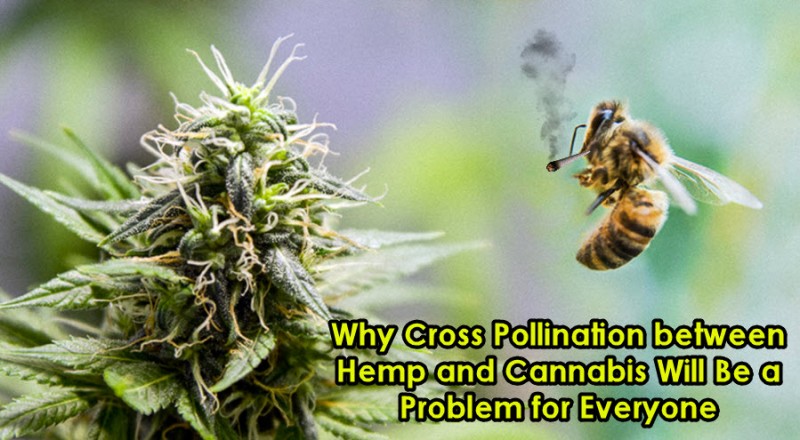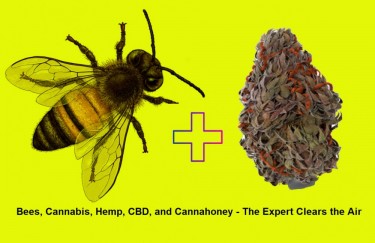Why Cross Pollination between legal hemp and cannabis can be a major problem for everyone!

As we enter into a new age of cannabis and hemp commerce, we’ll begin to see new challenges to overcome. While advocates would hope for a utopian transition into a cannabis-friendly world, in all likeliness we’ll have many proverbial “spills” to clean up before we have a functional system in the works.
One of these issues that was theorized for so long, are now becoming apparent in today’s cannabis climate. We’re talking about cross-pollination of course between legal hemp and legal cannabis.
Today – we’ll be taking a closer look at how this problem affects both legal cannabis and hemp, and what potential “solves” might be.
Cross Pollination – What’s the big deal?
If you ask any cannabis grower about how they treat their male plants, most of them will answer; “Oh, male plants? Whenever I see those nutsacks it’s straight to blender!”
Unless a grower wants to cross pollinate, having a male cannabis plant within your crop of females will absolutely ruin the overall potency of the crop.
In fact, a 1998 study by Meier and Mediavilla found that the presence of pollen decreased the yield of essential oils by 56% in cannabis flowers. This reduction in yield and potency and the presence of seeds dramatically decreases the crop value.
While industrial hemp farmers might think, “That’s a cannabis problem!” the truth of the matter is that if you’re growing hemp for CBD production – the same holds true. Cross pollination will reduce the yield of essential oils in your crops. This in turn will lower the returns.
For the marketplace, this means that we get a lower yield with the same demand. This means lower availability and a higher price tag.
You see, cross pollination doesn’t just affect the grower, it ultimately affects us all.
What can we do about it?
Currently, the most effective strategy has been to isolate grow sites. Making sure there’s at least 10 miles between each grow site can reduce the risk of cross pollination, however it’s not a perfect solve. Wild hemp and cannabis can also pollinate and a single male plant can produce up to 350,000 pollen grains and can travel great distances.
The other approach would be to grow hemp exclusively from clones. In some states, this is already the protocol, however the cannabis plant can change its sex.
If one plant within a field just so happens to switch sex and pollinate, it could ruin the entire crop. Meaning that even if you grow from pure clones or feminized seeds, you’d still have to do periodic sweeps of your field to ensure that you don’t have any male plants present.
One way to guarantee that there is no cross pollination is to isolate the grows in warehouses or greenhouses. While this is definitely an option, it does increase the cost of production as well as increase the demand for electricity and water. However, it does reduce the need for pesticides and water use can be regulated.
It also guarantees that there is no cross pollination, meaning that you have a higher assurance that you’ll get optimal returns on the crops produced. Perhaps this is enough to justify the increase in cost.
Nonetheless, if you’re going to be growing for mass production, outdoors will always reign supreme. The problem is when the rules of hemp and cannabis fields aren’t firmly established within a state, that issues like cross pollination becomes a thing.
Genetic Options
This is where many of you will cringe as you read the following sentences. In all likeliness, the “governmental solution” will come down to genetically modifying certain crops. This will most probably be industrial hemp, but certain cannabis strains might also undergo the “genetic change”.
While you might be on board or opposed to genetically engineering your crops, odds are that the industry (once the taboo period wears off) will opt for creating disease resistant crops that would not have the ability to cross pollinate.
Industrial hemp will be the first cannabis-like crop to undergo this transformation (if it hasn’t already) and I predict that after the United States legalizes recreational cannabis on a federal level, some cannabis crops will go the same route.
This is where the idea of “craft cannabis” will particularly become more important for many consumers. This will also, interestingly enough, be the same moment that cannabis undergoes its final transformation from “drug” to “good” within the social paradigm.
We’re not too far off from this reality. Nonetheless, the problems we’re facing today is quite alarming and important to solve. Right now, the industry has a few solutions, but nothing has been established to address the issue on a larger scale. Currently, most efforts seem like the industry is trying to contain a bunch of small fires – when a hell fire is brewing over the horizon.
Cross-pollination is an issue that affects us all because “NOBODY WANTS SEEDS IN THEIR WEED!”
BEES, CANNABIS, HEMP, HONEY, READ MORE...
WHY HEMP CROSS POLLINATING WITH MARIJUANA WILL COST MILLIONS!
OR..
WILL HEMP POLLEN EFFECT MARIJUANA PLANTS? READ THIS.
OR...
BEES, CANNABIS, HONEY, AND POLLINATION, READ THIS.
OR..
BEES AND HEMP PLANTS, HOW THEY WORK TOGETHER.










